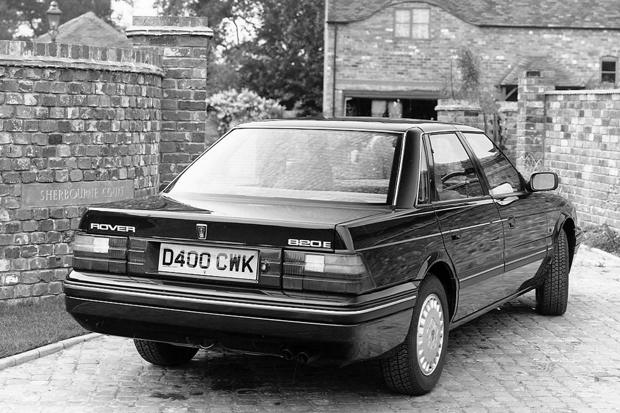Monday Motoring Classic: Rover 800

It may be remembered as the car of choice for Alan Partridge but in terms of Britain’s motoring history, the Rover 800 was a significant car. A very significant one.
It was the first truly collaborative effort between Austin-Rover and Honda. A partnership that began in 1979 when the British company’s boss, Michael Edwardes, signed a deal with the Japanese firm to reskin the Honda Ballade as the Triumph Acclaim.
The Acclaim became the last car to wear the Triumph badge and was replaced in 1984 by the Rover 200 (SD3), which had more Rover-specific content than its predecessor, but was still ostensibly a Honda Ballade in all but outward (keeping up) appearances.
The Rover 800 was different. It was to be a ground-up collaboration. A car that was neither based on a Honda nor based on a Rover, but would be engineered by both together.
For Rover, it would become the long overdue replacement for the revered Rover SD1. For Honda, it would give them a foothold in the USA, where its cars were proving popular but often too small and would also be the model to launch the upmarket ‘Acura’ brand.
Codenamed XX (or HX in Honda form), the agreement to develop the Rover 800 and Honda Legend was signed in November 1981. Honda would take care of the platform, V6 engines and gearboxes. Austin-Rover the four-cylinder engines and electrical architecture.
Exterior and interior styling were specific to each brand to ensure differentiation, but certain parts would have to remain the same for engineering reasons, namely the main body shell and glass areas.
Rover’s interpretation of the executive car theme was styled by Roy Axe and his team at their studio in Canley. It incorporated modern, aerodynamically efficient lines with a frontal family resemblance that had more than a hint of Austin Montego about it.

The A, B and C-pillars were painted satin black, to give the car the appearance of a floating roof, while the swage lines and ribbed rear light lenses were a nod to the Rover SD1, making it quite clear which car the new three-box saloon was replacing.
Indeed, the move towards a saloon body style for Rover was unusual – the Rover SD1 had been successful after a difficult start and rivals such as the Ford Scorpio and Renault 25 were going for the hatchback approach.
Honda, meanwhile, stirred up a bit of a hornet’s nest with the chassis design. Austin-Rover wanted something cheap and conventional, MacPherson struts, low production costs, ease of maintenance.
Honda, though, preferred a double wishbone design for the front suspension, which wouldn’t compromise the car’s low-slung styling. This, though, was significantly more complicated and expensive to build and gave the car a firm ride, traditionally Japanese, but not strictly aligned with others in the executive class.
Nevertheless, the Rover 800 made its debut on July 10, 1986, to general acclaim. The media liked the clean, modern styling, though some described it as a touch bland, while the packaging was considered good. Despite Rover’s concerns that the front suspension would eat into interior space, the rear legroom was exceptional, and the interior quality superb.
The Rover 800 was the first fully joint venture between Rover and Honda, and would set the bar for the upmarket levels of interior quality that would become the main differentiator between the two further down the line.

Trim levels were the miserable and slow-selling base 820 (with a 2.0-litre carb-fed O-Series engine identical to the of the Rover Montego), 820e and Se with an O-Series derived 16-valve engine (M16) and single point injection. The 820Si and SLi had multipoint injection while the 2.5 (Si) and 2.7-litre (Sterling) V6s from Honda, were typically high revving but indestructible.
The range-topping Sterling was a technical tour-de-force for Austin-Rover, with a solid state trip computer and advanced (albeit problematic) electronic management systems.
The Rover 800 was also the car with which Rover decided to once again enter the US market, launching the Sterling brand in the USA as a kind-of British version of Lexus. After 18 months, it was a flop, but this was largely a side-effect of price wars in the US domestic market pricing Sterling out of the market. Not helped by the fact that the big-for-Europe Rover 800 was a bit too compact for American tastes.
Back home, it went from strength to strength. And while the Honda Legend didn’t really do the job for Austin-Rover’s partner, the Rover 800 quickly became the UK’s best-selling executive car – a position it held onto for eight years, despite earning a reputation for flaky build quality, dodgy electronics and, on early cars at least, rampant corrosion.
Revelling in the sales success, Austin-Rover (soon to become Rover Group) took the Rover 800 concept further and right into the face of the Ford Granada. In 1988 it launched the Rover 800 Fastback, accompanied by the introduction of the ‘Vitesse’ performance model, with a TWR-designed bodykit and four-spoke alloys.
Aimed at more youthful buyers and those who’d stepped away from Rover following the demise of the hatchback Rover SD1, the Fastback was a massive success in the fleet market and helped strengthen Rover’s position. It also, unsurprisingly, echoed the silhouette of the Rover SD1.

Various changes occurred between 1988 and 1991, with chunkier bumpers, higher equipment levels and styling tweaks (plus the adorable lunacy of the 820 Tickford Turbo), but the biggest change to the Rover 800 range came in 1992, with the introduction of what was known internally as the R17.
In line with Rover’s corporate rebranding, moving the brand significantly upmarket, the R17 was effectively a Rover 800 facelift, but in many ways was much, much more.
The platform, bodyshell and glass were the same, as was the Honda 2.7-litre engine, but new 2.0-litre units, derived from the M16 and known as the T-Series, were introduced. Also new was the Vitesse Turbo – a T-series 2.0-litre fed by a Garrett turbocharger to develop 174bhp, or 202bhp in later Vitesse Sport guise.
Externally, the angularity of the Eighties was rounded off, replaced by a curvier, more modern look for the 1990s. The most significant changes were at the front, with a chrome grille replacing the Mk 1’s flat droop snoot, thicker bumpers and wider indicator lenses, sweeping deep into the front wings.
At the rear, rounded bumpers, a curvier bootlid with a lip to enhance high speed stability (a criticism of early saloons) and new rear lamp lenses rounded it off, while the interior layout was also all-new, with a perceived higher quality. The word ‘perceived’ is important here, as later R17s actually turned out to have far more trim rattles, annoying electrical faults and dashboards that would warp in extreme heat than the arguably simpler Mk 1s.
Also new for ’92 was the Rover 800 Coupe – a car originally conceived for the US market as a Sterling, and which was too far down the line to can once the Sterling venture had fizzled out. All Coupes were hand-finished, with bespoke interiors and were something of a market anomaly. Not a huge amount were built, but their survival rate is quite high.

The changes were enough to keep the Rover 800 at the top of the executive class until 1996, at which point sales across the entire sector started to tail off.
The Rover 800 was kept alive for a while thereafter, with new ‘smoked’ rear light lenses, some trim improvements and the introduction of Rover’s quad cam 2.5-litre KV6 engine in place of the Honda units. The last Rover 800 was built in 1998, to be replaced by the Rover 75 – a car that bore little relation to it other than the badge, but today attracts a similar kind of enthusiastic following.
For years, the Rover 800 sat in banger doldrums. Flakily built, expensive to run, unloved, thirsty and not remembered as a classic of its era, but as the car that Alan Partridge saw as a marker of success.
Its electrical complexity, low residual values and the collapse of Rover in 2005 further dented its appeal – indeed, more Rover 800s were disposed of during the 2009 Scrappage Scheme than remain on the UK’s roads today.
The Rover 800 could well be remembered for being the last true ‘big’ Rover (the Rover 75, after all, was much more compact), and while it may never attain the same level of desirability as the Rover SD1, it looks like its position as a bona fide classic is at last assured. Find a classic Rover for sale.
What's the best engine in the Rover 75?


